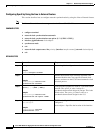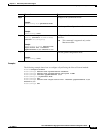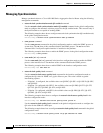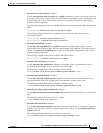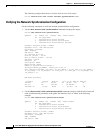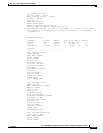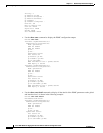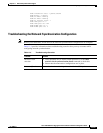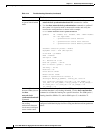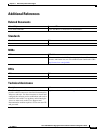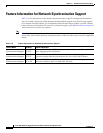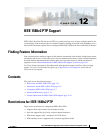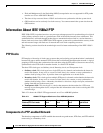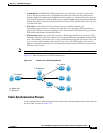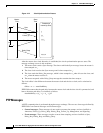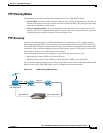
11-22
Cisco ASR 1000 Series Aggregation Services Routers Software Configuration Guide
OL-16506-17
Chapter 11 Network Synchronization Support
Configuring Network Synchronization
Incorrect clock limit set
or queue limit disabled
mode
• Verify that there are no alarms on the interfaces. Use the show
network-clock synchronization detail RP command to confirm.
• Use the show network-clock synchronization command to confirm if
the system is in revertive mode or nonrevertive mode and verify the
nonrevertive configurations as shown in this example:
Router#show network-clock synchronization
Symbols: En - Enable, Dis - Disable, Adis - Admin Disable
NA - Not Applicable
* - Synchronization source selected
# - Synchronization source force selected
& - Synchronization source manually switched
Automatic selection process : Enable
Equipment Clock : 1544 (EEC-Option2)
Clock Mode : QL-Enable
ESMC : Enabled
SSM Option : GEN1
T0 : External R0 t1 esf
Hold-off (global) : 300 ms
Wait-to-restore (global) : 300 sec
Tsm Delay : 180 ms
Revertive : No
Force Switch: FALSE
Manual Switch: FALSE
Number of synchronization sources: 2
sm(netsync NETCLK_QL_ENABLE), running yes, state 1A
Last transition recorded: (src_rem)-> 1A (src_added)-> 1A
(src_rem)-> 1A (src_added)-> 1A (ql_change)-> 1A (sf_change)->
1A (force_sw)-> 1C (clear_sw)-> 1A (sf_change)-> 1A
(sf_change)-> 1A
Incorrect QL values
observed when you use
the show
network-clock
synchronization detail
command
Use the network-clock synchronization SSM (option 1 |option 2) command
to confirm that there is no framing mismatch. Use the show run interface
command to validate the framing for a specific interface. For SSM option 1,
framing should be SDH or E1, and for SSM option 2, it should be T1.
Mismatched Physical
line coding
mechanisms between
clock source and input
source on the router
To ensure that this feature works correctly, both the ends need to be
configured with identical physical line coding mechanism and encapsulation
values.
Table 11-4 Troubleshooting Scenarios (continued)
Problem Solution



